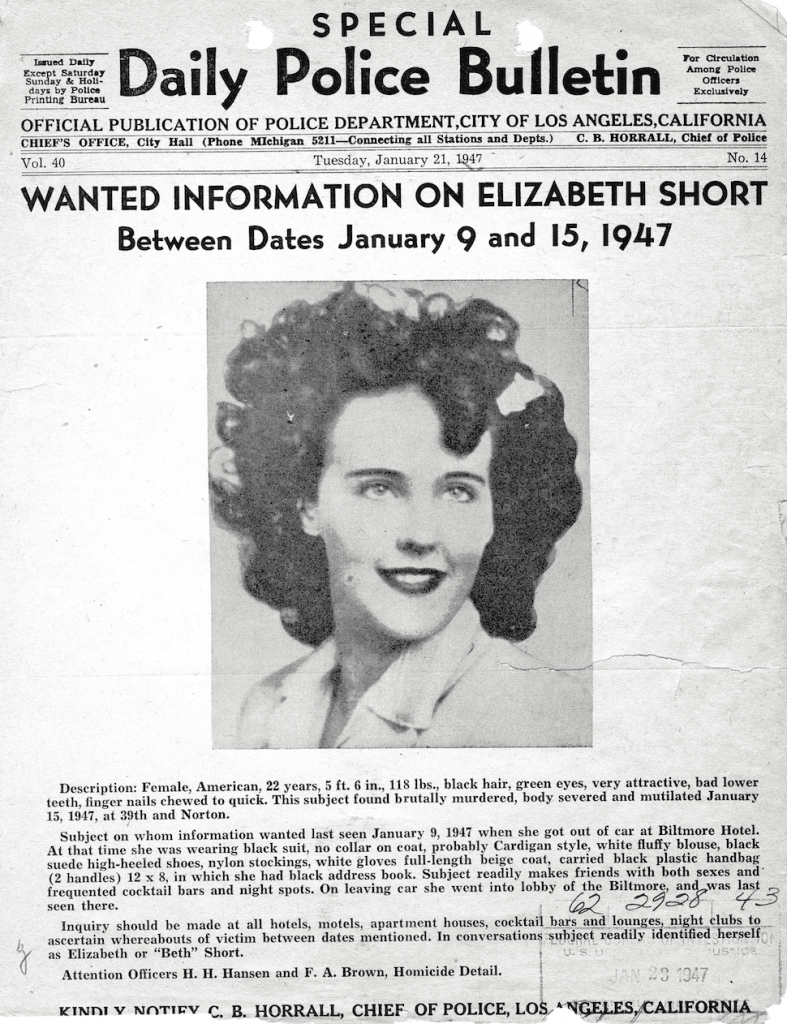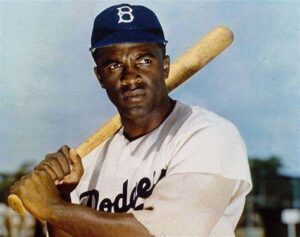Winner of the Fall 2019 StMU History Media Award for
Best Article in the Category of “Crime”
Elizabeth Short, widely known as The Black Dahlia, was a young 22-year-old American woman who was raped, brutally murdered, dismembered, and thrown on a vacant lot in a Los Angeles suburb for everyone to see. Elizabeth’s murder took place in Los Angeles County on January 15, 1947. No one knows the exact events that led to Elizabeth Short’s last moments when she fought for her life. There was no murder confession, and there was a lack of evidence to lead investigators further. Sadly, Elizabeth Short and her family never saw justice for her brutal murder. To this day, the case of The Black Dahlia is still unsolved. A man named Steve Hodel believed that The Black Dahlia murder was in fact not unsolved. Steve Hodel, a former detective, believed he had solved one of Los Angeles’ most notorious murders—but the infamous, troubled, charismatic doctor that Steve Hodel accused for being Short’s murderer, happened to be his own father, George Hodel.1
Elizabeth Short aspired to be an actress, and her young life was full of drinking and partying. She was very attracted to men and the sexual connections that came with men. Short had a desire to attend nightspots and nightclubs. Going to these nightspots, she frequently drew attention to herself, and she was arrested on September 23, 1943 for underage drinking of alcohol. She was only nineteen.2 By this time, Elizabeth had achieved a reputation as an aspiring actress who would go to bed with anyone who could possibly offer her a part in a movie.3 But her lifestyle soon led her to have a horrible encounter with a horrible man.

January 15, 1947 was just like any other day in the Los Angeles area. It was especially cool and overcast, which set the mood for the horrific discovery later that morning. A woman walking with her young daughter caught a glimpse of white flesh through a clump of brown grass in a vacant lot just a few inches from the sidewalk.4 They stumbled across the horrific sight of Elizabeth Short’s naked body cut in half just above the hipbone, drained of blood and arranged as if on display, with her legs spread and arms raised at right angles above her head. In a gruesome addition, two knife gashes extended her mouth up towards her ears.5 Her body also had the letters “B D” carved deeply into one thigh, and these letters were believed to represent the initials of Elizabeth Short’s well-known nickname Black Dahlia.6 This name stuck with her because of her tendency to always wear black clothing that contrasted with her white complexion, as well as having a dahlia flower in her hair on most occasions.7

George Hodel seemed to be an extraordinary man. He was a phenomenal doctor with a very respected reputation. Due to the extensive dismembering and perfect cuts discovered on Elizabeth’s body, her murderer had to have been a doctor.8 A couple years after the Black Dahlia murder, in 1949, Dr. Hodel’s reputation was left in tatters when he was tried for incest with his daughter Tamar Hodel, Steve Hodel’s half-sister.9 This trial brought light to George Hodel’s name in the police department. Because everyone knew that he was a very talented doctor, Dr. Hodel was put at the top of the suspect list for Elizabeth Short’s murder. Due to police corruption at the time, Dr. Hodel’s possible guilt was not presented to the public.
Dr. Hodel ended up passing away on May 16, 1999 due to a heart attack.10 Upon his passing, his son Steve Hodel began an intensive investigation into his father’s past. Steve Hodel made the trip to his father’s home to gather his father’s assets. While looking through his father’s belongings, Steve came across a tiny, palm-sized wood-bound photo album, with twelve golden fleurs-de-lys imprinted on the front.11 Inside this photo album, Steve discovered a number of strange photos of many familiar women. One of the women looked very similar to the Black Dahlia, Elizabeth Short. There were two photos of this women. In one, the woman had paper dahlia flowers in her hair. In the other, the woman was nude with her eyes shut.12 After Steve realized that the women in his father’s old photo album was the Black Dahlia, he became determined to find answers, to possibly clear his father’s name in the eyes of the law. Shortly into his private investigation, Steve Hodel realized that the evidence he was uncovering led to his father’s obvious guilt, not his exoneration. Now he wanted only to do all he could to prove it.
When Steve Hodel started the investigation into his father’s connection to the murder of the Black Dahlia, he found a substantial amount of sufficient yet circumstantial evidence against him. He soon found out that his father and Elizabeth Short knew each other. They had met in 1944 and had begun a non-sexual relationship. George would provide Elizabeth with financial aid for food and rent whenever she needed it in return for showing love interest in George. Steve’s suspicions of his father’s guilt skyrocketed when he came to find out that Elizabeth and his father were together at a downtown hotel three days before Elizabeth’s body was found. During the course of Steve Hodel’s investigation, he recognized his father’s unique handwriting multiple times, especially on the original note mailed by the Black Dahlia Avenger to the LAPD and to the press. The note with his father’s handwriting read “Here it is; Turning in Wed; Jan. 29 10 A.M.; Had my fun at police; Black Dahlia Avenger.” This was the first note that the Black Dahlia Avenger made no attempt to distort or conceal his actual handwriting.13 Hand writing analysis has since confirmed these claims. Although this evidence is circumstantial, Steve Hodel was very passionate in proving his father’s guilt. Another piece of incriminating evidence was a white-faced military watch that Dr. Hodel was seen wearing in contemporary photographs. A similar watch was found in the vacant lot close to where Elizabeth’s body was found.14
A number of men and one woman confessed to the crime, but none of them were able to match the gory details of the slaying known only by the police.15 Elizabeth’s murder seemed to bring out the worst among the psychologically disturbed in the Los Angeles area. The police were overwhelmed with the number of people who confessed to the murder.16 Despite all of these possible killers, Steve Hodel still truly believes that George Hodel was the guilty one.

The former detective for the LAPD and George Hodel’s son, Steve Hodel, had concluded his investigation on his father’s guilt, and developed an accurate timeline and detailed insight into Elizabeth Short’s last moments. Steve Hodel believes that the torture began on January 14, 1947 around 3:00-4:00 PM. Around this time, George Hodel took Elizabeth Short to the Franklin House. He gagged her mouth, bound her hands and feet with rope, and then began a prolonged and systematic process in which Elizabeth was beaten and subjected to ritualistic and sadistic torture.17 The torture included, but was not limited to the infliction of minor cuts to her body. She was beaten and kicked about her entire body, and she was forced to eat her own or his fecal excrement. Large pieces of flesh were cut from Elizabeth’s body and inserted into her orifices. Her face and breasts were also cut to imitate two of Man Ray’s famous photographs.18 Following this unimaginable torture, George Hodel then proceeded to sexually assault the then-slain Elizabeth Short.19 Although Elizabeth Short’s murderer was never convicted, it is now widely believed that George Hodel is the guilty one. The case of the Black Dahlia is considered an unsolved murder to this day, which makes it the most horrific unsolved murder in American history.20 Steve Hodel did not start his investigation until after George Hodel passed away, and only then because he passed away. George Hodel got away with his crime for over forty years. And even if he had not passed away until later in his life, face it, he still probably wouldn’t have ever been held to pay for his crime.
- Grace Bradberry, “My father was the Black Dahlia killer,” The Times, April 24, 2003. ↵
- Steve Hodel, Black Dahlia Avenger: A Genius for Murder (New York: Arcade Pub., 2003), 18. ↵
- Spectacular Crimes of the 1940s, 2007, s.v. “The Black Dahlia Case.” ↵
- Steve Hodel, Black Dahlia Avenger: A Genius for Murder (New York: Arcade Pub., 2003), 10. ↵
- Grace Bradberry, “My father was the Black Dahlia killer,” The Times, April 24, 2003. ↵
- Women in World History: A Biographical Encyclopedia, 2002, s.v. “Short,Elizabeth(1925–1947),” by Anne Commire. ↵
- Women in World History: A Biographical Encyclopedia, 2002, s.v. “Short,Elizabeth(1925–1947),” by Anne Commire. ↵
- Grace Bradberry, “My father was the Black Dahlia killer,” The Times, April 24, 2003. ↵
- Grace Bradberry, “My father was the Black Dahlia killer,” The Times, April 24, 2003. ↵
- Steve Hodel, Black Dahlia Avenger: A Genius for Murder (New York: Arcade Pub., 2003), 22. ↵
- Steve Hodel, Black Dahlia Avenger: A Genius for Murder (New York: Arcade Pub., 2003), 36. ↵
- Grace Bradberry, “My father was the Black Dahlia killer,” The Times, April 24, 2003. ↵
- Steve Hodel, Black Dahlia Avenger: A Genius for Murder (New York: Arcade Pub., 2003), 273. ↵
- Steve Hodel, Black Dahlia Avenger: A Genius for Murder (New York: Arcade Pub., 2003), 445. ↵
- Women in World History: A Biographical Encyclopedia, 2002, s.v. “Short, Elizabeth (1925–1947),” by Anne Commire. ↵
- Spectacular Crimes of the 1940s, 2007, s.v. “The Black Dahlia Case.” ↵
- Steve Hodel, Black Dahlia Avenger: A Genius for Murder (New York: Arcade Pub., 2003), 434. ↵
- Steve Hodel, Black Dahlia Avenger: A Genius for Murder (New York: Arcade Pub., 2003), 445. ↵
- Steve Hodel, Black Dahlia Avenger: A Genius for Murder (New York: Arcade Pub., 2003), 434. ↵
- Women in World History: A Biographical Encyclopedia, 2002, s.v. “Short, Elizabeth(1925–1947),” by Anne Commire. ↵



115 comments
Cassandra Sanchez
I have never heard of the Black Dahlia or her story before and it is very saddening and shocking to read about. Elizabeth went through harsh treatment before she was killed and it is upsetting how the person who did this was never found guilty. I found it interesting how George Hodel’s own son went and actually found some evidence that could be used against his father.
Todd Brauckmiller Jr.
Wow never would I have imagined a murder case this horrific would happen. For the case to go in a bad decision is just a shame. Now I understand that Elizabeth did some questionable things but it did not need to escalate in her getting murdered. This was a thrilled article and I think you did a great job writing this crime story.
Rosa Robledo Martinez
It is very sad to hear all the torture that Elizabeth went through. At the beginning of the article I didn’t expect to know so much details about what she went through and everything they made her do. I find it very disgusting that they made her eat the things she did. It’s sad that they didn’t find actual justice for Elizabeth and her family.
Kristina Tijerina
This article was gruesome to read. I cannot imagine the pain Elizabeth Short went through during her time with her murderer. Her injustice was and is horrendous. The fact that her murderer got away with his actions for forty years and was never found is baffling. She was a young and beautiful girl. The way she chose to live her life should not have led to her death. It’s relieving to know that George Hodel’s son came forward and tried to solve the case after he came to the conclusion that his father might not be innocent in this case. However, it is unfortunate that Short’s murderer walked free for forty years after her death.
Doan Mai
I have heard of Kurt Cobain but not the band Nirvana. I never knew that Kurt Cobain was in such pain because of his stomach illness that he had to use drugs to ease the pain and that he had an alcohol problem, which soon was a severe issue for him. It is sad to know such a talent like him had ended his life at a young age.
Doan Mai
The injustice in the “Black Dahlia” case immensely frustrated me that how a dangerous criminal could get away with his crime that easy. He had committed a horrible crime to Elizabeth Short, a young woman soon to be an actress who was raped and murdered. Her case was shut down without knowing who the murderer was left, the poor girl, and her family in great sorrow.
Mitchell Yocham
It is so awful to read what George Hodel got away with, not only did he have a non-sexual relationship with her, he was paying her to be able to live. However, whatever took him over the edge, the way that he tortured her was just inhumane and horrifying. Although Elizabeth Short was borderline a prostitute, the way that she was murdered was just horrible and no one deserves the treatment she received.
Felipe Macias
The fact that the murderer was never caught seems like it would happen much more often. Investigators and detectives have very little to no evidence to work with. Though it is unfortunate that Short was horrifically killed in that fashion, she was not in a very good spot to begin with and is just as important. There is no easy way to cheat yourself into the way of life you want to achieve.
Courtney Pena
It is unfortunate that Elizabeth Short and her family never saw justice for her murder and that the case is still unsolved even though it has been 82 years since the murder happened. However, George Hodel is seen as the guilty one but was never convicted because his son started investigating the case once his father passed away. I wonder how Steve felt after realizing all the information about his father and Elizabeth Short.
Aaron Peters
Great article, however what a truly sad story. The police’s inability to convict a man desptie having ample evidence was truly disappointing, Elizabeth having her life cut so short and having such a massive injustice happen to her even after death seems really horrid. I found the description of what George did to Elizabeth Short to be the worst part of the case, It just hammers home how violent of a crime was done against her.